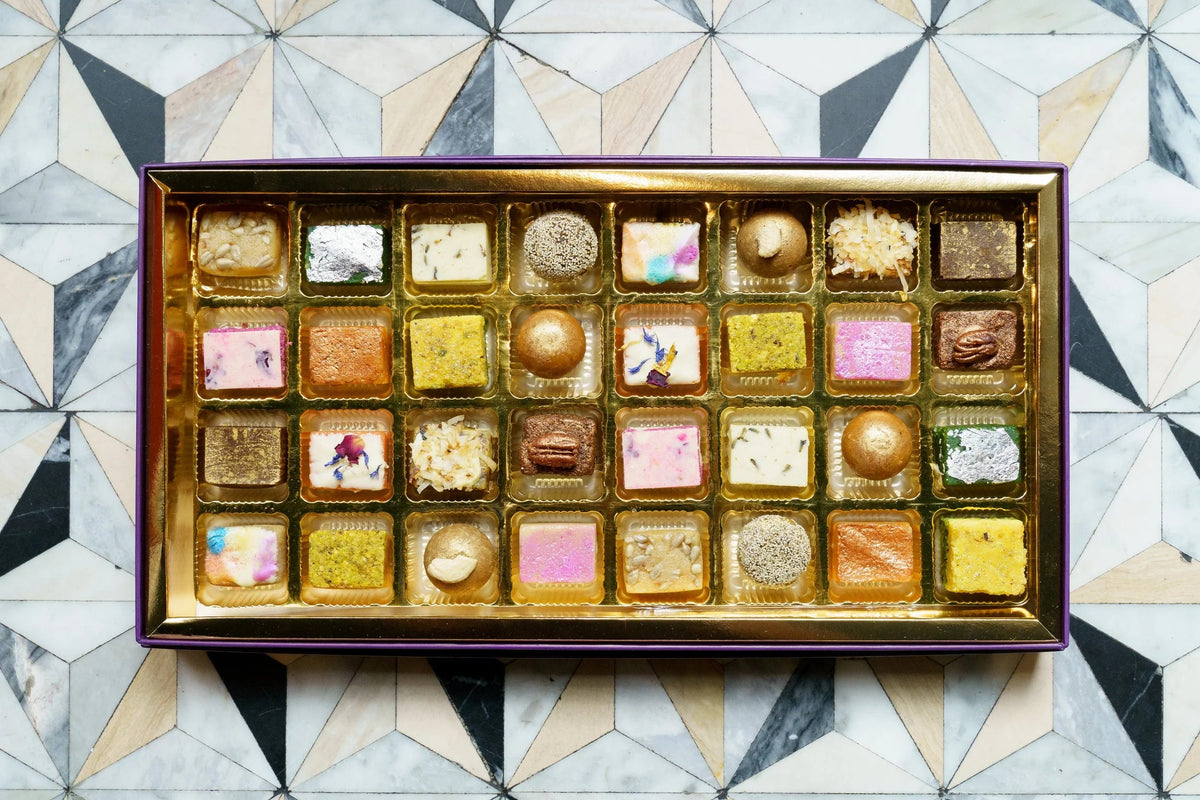Hosting? Gifting? Or just stocking your freezer? Order 5 boxes of the same size and we’ll sweeten the deal with 5% off.

This time of year, desis everywhere from Jaipur to Jackson Heights head to their local mithaiwala to stock up on boxes of Indian mithai sweets that will be given as Diwali gifts, or unboxed as dessert for the holiday’s weeklong festivities. Our own mithaiwali, chef Surbhi, is hard at work with our team grinding nuts into powder, filling molds, and dusting mithai with sparkling dust.
Mithai, the Hindi word for sweets, represents a diverse array of confections, each with their own regional distinctions and culinary techniques that date back thousands of years.
Mithai are given alongside prayers to the gods, gifts at weddings, births and festivals, and are a daily snack with tea time. They are distinctly South Asian but have evolved with the spice trade, colonization and global trade, with influences from Persian halva to European pastries, and even share traits with deep-fried fair food across the Midwest — fried dough unites us all. Yet, outside of communities on the Indian subcontinent and here in the diaspora, many of our most beloved South Asian sweets are still fairly uncommon.
In recent decades, food from the Indian subcontinent has permeated the U.S. culinary landscape beyond chana masala and butter chicken. A taste for regional South Asian cuisine is growing, and along with it, understanding of its evolution as it crosses over into the diaspora. But among the pillars of our expansive cuisine, sweets are still largely unfamiliar to non-South Asians.
Everyone knows what Turkish delights and petit fours are — why not mithai?
That moment when you bite into a fudgy Pistachio Burfi or crack the thin shell of a Besan Ladoo is unrivaled, and the floral fragrance of kheer sends us down deep portals of childhood memory. We want everyone to experience mithai. By eating our food, you can better understand South Asian culture’s particular language of love and ongoing rebirth.
The Indian subcontinent is overdue for recognition of its confectionery legacy. Sugarcane has been a staple crop on the Indian subcontinent for millennia, and the Indus Valley civilization invented the process by which sugar is refined more than 8,000 years ago.
“Mithai comes from mithas, meaning ‘sweet'. The root of ‘sugar’ is from the Sanskrit word sharkara, and even ‘candy’ (originally khanda) is derived from this ancient dialect. Just as French dessert and Italian dolce house a myriad of tidbits laden with sucrose and fat, so too does the wonderous world of mithai,” writes Deepi Aluwalia.
Composed of base ingredients like toasted nuts, curdled milk solids and fried dough, mithai are versatile with a wide range of textural and aromatic characteristics.
Our mithai resemble bite-size pieces of art thanks to chef Surbhi’s eye for detail and influence from her father, who is an abstract artist.
Each piece is hand-decorated in various glittering jewel-tones with dried flower petals, candied ginger, whole nuts or seeds. They are packaged in colorful gift boxes that we design in-house (shout out to Lynn!), and are made to be gifted.
The cost of each box reflects the care that went into it, from the quality of ingredients to the labor of our staff. We value every component of the process and don’t cut corners, making each piece all the more precious.
Sugary, dairy-laden sweets can be off limits for some people, so we cater to dietary needs like vegan, gluten-free and nut-free, and we don’t use preservatives. We use less sugar than traditional mithai shops, allowing the delicate balance of our ingredient pairings to shine: Toasted coconut, pecan flour, black pepper. Carrots, almonds, calendula petals. Moong dal, saffron, pistachios, and more.
This year, we are ringing in the Diwali season with six new gift boxes including our Desi Collection of nostalgic flavors, an expanded Vegan Collection, and the star of the show, the Diwali Collection with sixteen flavors. Our handmade collections feature classic mithai flavors as well as unconventional creations like Lavender Burfi and Salted Pecan Burfi, and veganized favorites like Kaju Katli and Badam Narangi.
Okay, now we’re hungry.
We hope you’re inspired to share mithai this Diwali — whether you buy it from our small business or make it at home with your loved ones — and learn more about the history of this ancient confectionery.
Happy Diwali!



